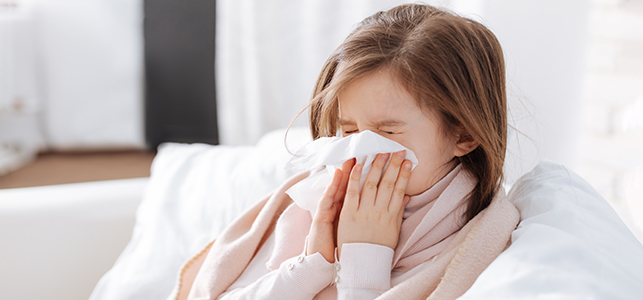
6 questions about mucus with a pediatric pulmonologist
Whether your family is dealing with allergies or yet another cold virus, winter is prime time for snot, phlegm and mucus. While they’re not pretty to think about, these sticky, slimy substances are essential for lung health.
Dr. Bruce Rubin, pediatric pulmonologist, has spent the past 40 years studying mucus secretion and clearance as an engineer and a physician. He’s published dozens of research papers and a book on the topic. Here, he answers families’ most frequently asked questions about the ooey, gooey – but oh so important – substances in our lungs and noses.
Are mucus, snot and phlegm the same thing?
Mucus lines the moist surfaces of the body, including the lungs, sinuses, mouth, eyes, and even the stomach and intestines; it is usually clear or grey. Snot is the substance produced in the nose and sinuses during an infection. Lung phlegm is the good mucus mixed with inflammatory cells that gives it color. Green or yellow phlegm does not always mean an infection.
What’s the purpose of mucus in the human body?
Mucus prevents drying of these surfaces that are intended to remain moist. Normal mucus also protects the body by trapping pollutants and illness-causing microbes in the nose and lungs. Our body automatically makes more mucus during an infection or allergy as extra protection.
Every time we take a breath, there’s a chance we’re inhaling bacteria, viruses, dirt and dust. Ideally, these unwanted invaders will stick to the mucus and be ushered out of our airways by the teeny hairlike structures in the lungs called cilia. At that point, we usually blow the mucus and trapped materials out our nose or cough them up and safely swallow them for our stomach to break down and expel when we use the bathroom.
We’re always producing mucus, but we typically don’t notice until our bodies produce more of it. When fighting an infection, mucous membranes can become inflamed and stimulate production of more mucus. In the case of allergies, the body’s immune system overreacts to substances like pollen or dust and releases substances that can cause glands to make more mucus. This is the body’s way of protecting itself, but it can be bothersome in the form of a runny or clogged nose, cough or sore throat from post-nasal drip in the back of the throat in the process.
Can you tell anything important from the color of mucus?
As we’ve already addressed, too much mucus can be a sign of allergy or infection which can also thicken mucus and turn it yellow/green. Black mucus almost always means exposure to pollutants or smoke. Yes, we can sometimes tell if a child has been around smokers a lot by looking in their nose – or at what comes out of it! That said, the color of the mucus isn’t nearly as important as other symptoms like fever or itching for us to understand if something is wrong.
When should parents consult the doctor about a child’s mucus?
There are no specific types of mucus that alone would automatically prompt a doctor's visit. I would recommend checking in with your child’s pediatrician if congestion, runny nose or cough lasts more than four weeks or is accompanied by:
- Breathing difficulty or shortness of breath
- Fever of 104°F or higher
- Mucus that contains blood
You know your child best, so if you have concerns give the doctor a call!
Do you recommend over-the-counter medications to curb mucus production in kids?
No! Based in large part on my extensive research, the FDA has stated that over-the-counter medications for mucus problems are ineffective and can even be dangerous in children. Various chest or vapor rubs, for example, increase mucus production through stimulation of something called the transient receptor potential. This can be dangerous for some very young children.
Humidifiers also do not help and high humidity in a bedroom can promote the growth of mold.
Are there safe approaches to help kids find relied from too much bothersome mucus?
Nasal saline can help the nose and sinuses drain better and, for some children with chronic and severe lung diseases, we can prescribe medications or devices to help clear chest phlegm. For a cold with cough or dripping nose, the best therapy is time and rest.
